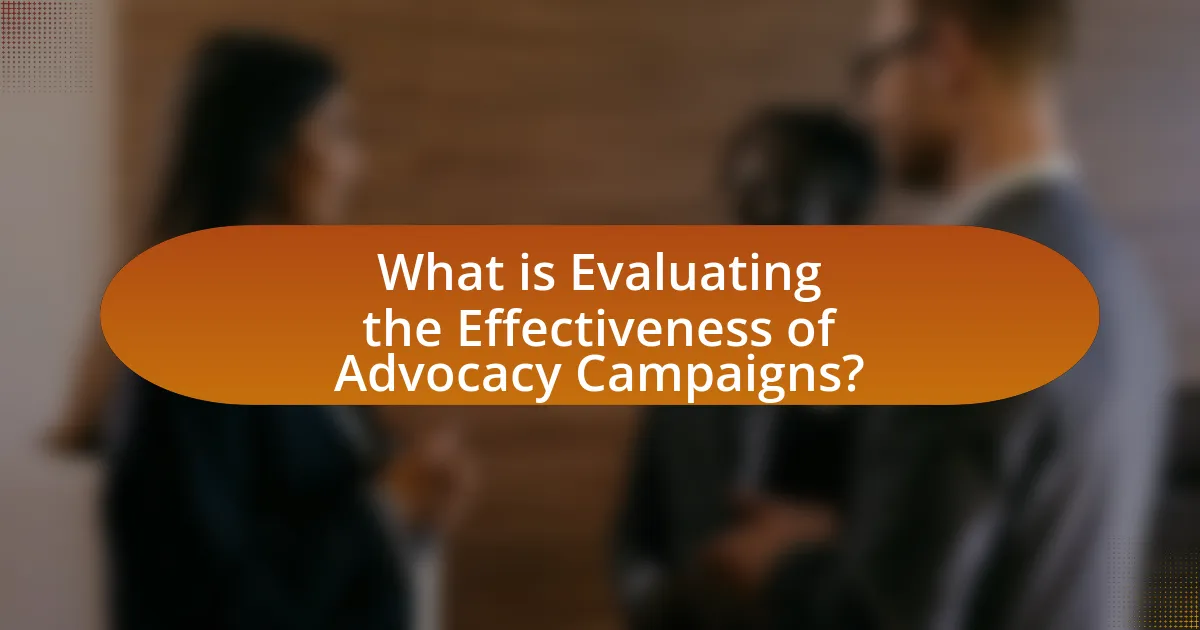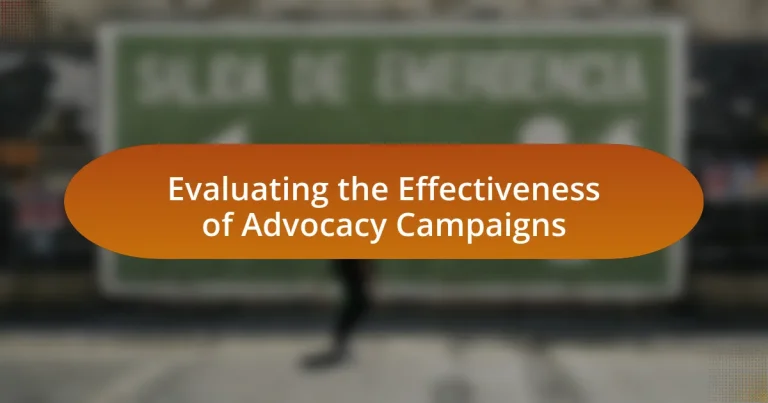Evaluating the effectiveness of advocacy campaigns is a systematic process that assesses how well these initiatives achieve their goals and influence public opinion or policy change. This article outlines the importance of evaluation, highlighting its role in improving decision-making and resource allocation for advocacy organizations. Key objectives of advocacy campaigns, such as raising awareness and driving policy change, are discussed alongside common evaluation methods, including qualitative and quantitative approaches. The article also addresses challenges faced in evaluation, such as resource limitations and cognitive biases, and emphasizes best practices for establishing a clear evaluation framework to enhance campaign effectiveness.

What is Evaluating the Effectiveness of Advocacy Campaigns?
Evaluating the effectiveness of advocacy campaigns involves assessing how well these campaigns achieve their intended goals and influence public opinion or policy change. This evaluation typically includes measuring specific outcomes, such as changes in awareness, attitudes, or behaviors among the target audience, as well as analyzing the campaign’s reach and engagement metrics. For instance, a study by the Pew Research Center found that advocacy campaigns that utilize social media effectively can increase public engagement by up to 50%, demonstrating the importance of strategic communication in achieving advocacy objectives.
Why is it important to evaluate advocacy campaigns?
Evaluating advocacy campaigns is crucial for determining their effectiveness and impact. This evaluation allows organizations to assess whether their strategies are achieving desired outcomes, such as influencing public policy or raising awareness on critical issues. For instance, a study by the Center for Evaluation Innovation found that 70% of advocacy organizations that regularly evaluate their campaigns report improved decision-making and resource allocation. By analyzing data and feedback, organizations can refine their approaches, enhance engagement, and ultimately increase their chances of success in achieving advocacy goals.
What are the key objectives of advocacy campaigns?
The key objectives of advocacy campaigns are to raise awareness, influence public opinion, and drive policy change. Advocacy campaigns aim to educate the public and stakeholders about specific issues, thereby increasing awareness and understanding. For instance, campaigns like the “Ice Bucket Challenge” successfully raised awareness about ALS, leading to increased funding for research. Additionally, advocacy campaigns seek to influence decision-makers by mobilizing community support and presenting evidence-based arguments, as seen in campaigns for climate action that have led to legislative changes in various countries. Ultimately, these campaigns strive to create measurable impacts on policies and practices, demonstrating their effectiveness through tangible outcomes such as new laws or shifts in public behavior.
How does evaluation contribute to achieving these objectives?
Evaluation contributes to achieving the objectives of advocacy campaigns by systematically assessing their impact and effectiveness. Through evaluation, organizations can identify which strategies are successful in influencing public opinion or policy change, allowing for data-driven adjustments to enhance future efforts. For instance, a study by the Center for Evaluation Innovation found that campaigns that utilized evaluation data were 30% more likely to achieve their intended outcomes compared to those that did not. This demonstrates that evaluation not only measures success but also informs strategic decision-making, ultimately leading to more effective advocacy initiatives.
What are the common methods used for evaluation?
Common methods used for evaluation of advocacy campaigns include surveys, focus groups, interviews, and analysis of campaign metrics. Surveys collect quantitative data on audience awareness and attitudes, while focus groups provide qualitative insights into perceptions and motivations. Interviews allow for in-depth understanding of stakeholder experiences, and analysis of campaign metrics, such as social media engagement and website traffic, offers measurable indicators of campaign reach and effectiveness. These methods collectively enable a comprehensive assessment of advocacy campaign outcomes and impact.
What qualitative methods can be employed in evaluation?
Qualitative methods employed in evaluation include interviews, focus groups, case studies, and participant observations. Interviews allow for in-depth exploration of individual perspectives, while focus groups facilitate discussion among participants to gather diverse viewpoints. Case studies provide comprehensive insights into specific instances of advocacy campaigns, and participant observations enable evaluators to witness behaviors and interactions in real-time. These methods are effective in capturing the nuances of human experiences and understanding the context of advocacy efforts, thereby enhancing the evaluation process.
What quantitative methods are effective for measuring impact?
Surveys and statistical analysis are effective quantitative methods for measuring impact. Surveys can collect data on participant attitudes, behaviors, and demographics, allowing for the assessment of changes over time. Statistical analysis, including regression models and hypothesis testing, can quantify the relationship between advocacy efforts and observed outcomes. For instance, a study published in the Journal of Public Health found that surveys measuring community awareness before and after a health campaign showed a significant increase in knowledge, demonstrating the campaign’s impact quantitatively.
What challenges are faced in evaluating advocacy campaigns?
Evaluating advocacy campaigns faces several challenges, including measuring impact, establishing causality, and accounting for external factors. Measuring impact is difficult because advocacy efforts often aim for long-term societal changes that are not easily quantifiable. Establishing causality presents a challenge as it can be hard to determine whether changes in public opinion or policy are directly attributable to the campaign or influenced by other events. Additionally, external factors such as political climate, media coverage, and public sentiment can significantly affect outcomes, complicating the evaluation process. These challenges highlight the complexity of assessing the effectiveness of advocacy campaigns accurately.
How do resource limitations affect evaluation efforts?
Resource limitations significantly hinder evaluation efforts by restricting the availability of necessary tools, personnel, and funding. When organizations face budget constraints, they often lack the capacity to conduct comprehensive assessments, leading to incomplete data collection and analysis. For instance, a study by the American Evaluation Association found that 60% of evaluators reported insufficient resources as a primary barrier to effective evaluation, resulting in less reliable outcomes and diminished learning opportunities. This limitation can ultimately compromise the ability to measure the true impact of advocacy campaigns, making it difficult to refine strategies and demonstrate accountability to stakeholders.
What biases can influence the evaluation process?
Cognitive biases such as confirmation bias, anchoring bias, and availability heuristic can significantly influence the evaluation process. Confirmation bias occurs when evaluators favor information that confirms their pre-existing beliefs, leading to skewed assessments of advocacy campaign effectiveness. Anchoring bias involves relying too heavily on the first piece of information encountered, which can distort subsequent evaluations. The availability heuristic causes evaluators to overestimate the importance of information that is readily available or memorable, often neglecting more relevant data. These biases can compromise the objectivity and accuracy of evaluations, ultimately affecting the perceived success of advocacy campaigns.

How can the effectiveness of advocacy campaigns be measured?
The effectiveness of advocacy campaigns can be measured through specific metrics such as changes in public awareness, shifts in policy, and engagement levels. These metrics provide quantifiable data that reflect the campaign’s impact. For instance, surveys can assess changes in public opinion before and after a campaign, while tracking legislative actions can indicate policy shifts influenced by advocacy efforts. Additionally, social media engagement metrics, such as shares and comments, can quantify public interaction and support for the campaign. Studies have shown that campaigns that effectively utilize these measurement tools can demonstrate a direct correlation between their efforts and tangible outcomes, reinforcing the importance of data-driven evaluation in advocacy.
What metrics are commonly used in evaluation?
Commonly used metrics in evaluation include reach, engagement, conversion rates, and impact assessment. Reach measures the number of individuals exposed to the campaign, while engagement quantifies interactions such as likes, shares, and comments. Conversion rates indicate the percentage of individuals who take a desired action, such as signing a petition or donating. Impact assessment evaluates the campaign’s effectiveness in achieving its goals, often through surveys or changes in public opinion. These metrics provide a comprehensive understanding of an advocacy campaign’s performance and effectiveness.
How do output metrics differ from outcome metrics?
Output metrics measure the direct activities and outputs of an advocacy campaign, such as the number of events held or materials distributed, while outcome metrics assess the broader impacts and changes resulting from those activities, such as shifts in public opinion or policy changes. For example, an output metric might quantify the number of brochures handed out, whereas an outcome metric would evaluate whether those brochures led to increased awareness or action among the target audience. This distinction is crucial for understanding the effectiveness of advocacy efforts, as outputs alone do not guarantee meaningful outcomes.
What role do indicators play in measuring effectiveness?
Indicators serve as essential tools in measuring effectiveness by providing quantifiable data that reflects the success of advocacy campaigns. They allow organizations to assess progress towards specific goals, enabling the identification of strengths and weaknesses in strategies. For instance, a study by the World Health Organization highlights that using indicators such as the number of policy changes or public engagement metrics can directly correlate with the effectiveness of health advocacy efforts. This data-driven approach ensures that decisions are informed by concrete evidence, facilitating continuous improvement in campaign strategies.
How can stakeholder feedback enhance evaluation?
Stakeholder feedback enhances evaluation by providing diverse perspectives that inform the assessment process. This feedback allows evaluators to identify strengths and weaknesses in advocacy campaigns, ensuring that the evaluation reflects the experiences and insights of those directly affected. For instance, a study by the American Evaluation Association highlights that incorporating stakeholder input leads to more relevant and actionable evaluation findings, ultimately improving program effectiveness. By integrating stakeholder feedback, evaluators can make informed decisions that align with the needs and expectations of the community, thereby increasing the overall impact of advocacy efforts.
What methods can be used to gather stakeholder feedback?
Surveys and interviews are effective methods to gather stakeholder feedback. Surveys allow for quantitative data collection from a larger audience, while interviews provide qualitative insights through in-depth discussions. According to a study published in the Journal of Public Affairs, utilizing both methods can enhance understanding of stakeholder perspectives and improve advocacy strategies.
How does stakeholder engagement influence campaign adjustments?
Stakeholder engagement significantly influences campaign adjustments by providing critical feedback and insights that shape strategic decisions. Engaged stakeholders, including community members, partners, and funders, offer diverse perspectives that can highlight areas for improvement or new opportunities. For instance, a study by the International Association for Public Participation found that campaigns with active stakeholder involvement are 60% more likely to achieve their objectives, as they can adapt messaging and tactics based on real-time input. This responsiveness to stakeholder feedback ensures that campaigns remain relevant and effective in addressing the needs and concerns of the target audience.

What are the best practices for evaluating advocacy campaigns?
The best practices for evaluating advocacy campaigns include setting clear objectives, using both qualitative and quantitative metrics, and engaging stakeholders throughout the evaluation process. Clear objectives provide a framework for measuring success, while qualitative metrics, such as interviews and focus groups, offer insights into the campaign’s impact on target audiences. Quantitative metrics, such as surveys and data analysis, allow for measurable outcomes, such as changes in public opinion or policy shifts. Engaging stakeholders, including community members and partners, ensures that the evaluation reflects diverse perspectives and enhances the credibility of the findings. These practices are supported by research indicating that comprehensive evaluations lead to more effective advocacy strategies and improved outcomes.
How can a clear evaluation framework be established?
A clear evaluation framework can be established by defining specific objectives, selecting appropriate indicators, and implementing systematic data collection methods. First, objectives should align with the overall goals of the advocacy campaign, ensuring they are measurable and relevant. For instance, if the goal is to increase public awareness, an objective could be to raise awareness levels by a certain percentage within a defined timeframe.
Next, selecting indicators involves identifying quantifiable metrics that reflect progress towards these objectives, such as survey results or social media engagement statistics. Finally, systematic data collection methods, such as pre- and post-campaign surveys or focus groups, should be employed to gather reliable data. This structured approach ensures that the evaluation framework is comprehensive and capable of providing actionable insights into the campaign’s effectiveness.
What elements should be included in an evaluation framework?
An evaluation framework for advocacy campaigns should include the following elements: clear objectives, measurable indicators, data collection methods, analysis plan, and reporting mechanisms. Clear objectives define what the campaign aims to achieve, while measurable indicators provide specific criteria to assess progress. Data collection methods outline how information will be gathered, ensuring reliability and validity. An analysis plan details how the collected data will be interpreted to draw conclusions about effectiveness. Finally, reporting mechanisms ensure that findings are communicated to stakeholders, facilitating transparency and accountability. These elements collectively enable a comprehensive assessment of advocacy campaign effectiveness.
How can goals and objectives be aligned with evaluation criteria?
Goals and objectives can be aligned with evaluation criteria by ensuring that the criteria directly measure the outcomes specified in the goals and objectives. This alignment involves defining clear, measurable indicators that reflect the intended results of the advocacy campaign, such as increased awareness or behavior change. For instance, if a goal is to raise public awareness about a health issue, the evaluation criteria could include metrics like survey results showing changes in public knowledge or engagement levels. This method ensures that the evaluation process accurately assesses the effectiveness of the campaign in achieving its stated aims.
What role does continuous improvement play in advocacy evaluation?
Continuous improvement is essential in advocacy evaluation as it ensures that strategies and practices are consistently refined to enhance effectiveness. By systematically assessing outcomes and processes, advocacy organizations can identify strengths and weaknesses, allowing for data-driven adjustments. For instance, the use of feedback loops and performance metrics enables organizations to adapt their approaches based on real-time insights, leading to more impactful campaigns. Research indicates that organizations employing continuous improvement methodologies, such as Plan-Do-Study-Act cycles, achieve higher success rates in their advocacy efforts, demonstrating the critical role of this practice in optimizing outcomes.
How can lessons learned from evaluations inform future campaigns?
Lessons learned from evaluations can inform future campaigns by identifying successful strategies and areas for improvement. Evaluations provide data on what worked and what did not, allowing campaigners to refine their approaches based on evidence. For instance, a study by the Campaign for Tobacco-Free Kids found that campaigns utilizing targeted messaging significantly increased public support for tobacco control policies. This data-driven insight enables future campaigns to adopt similar effective strategies while avoiding past mistakes, ultimately enhancing their overall impact and efficiency.
What strategies can be implemented for ongoing evaluation?
Ongoing evaluation of advocacy campaigns can be implemented through strategies such as continuous data collection, stakeholder feedback, and performance metrics analysis. Continuous data collection involves regularly gathering quantitative and qualitative data to assess campaign progress and impact. Stakeholder feedback, including insights from target audiences and partners, provides real-time perspectives on campaign effectiveness. Performance metrics analysis utilizes specific indicators, such as engagement rates and policy changes, to measure success against predefined goals. These strategies ensure that advocacy efforts remain adaptive and responsive to changing circumstances, ultimately enhancing their effectiveness.
What practical tips can enhance the evaluation process?
To enhance the evaluation process of advocacy campaigns, implement clear objectives and measurable outcomes. Establishing specific, quantifiable goals allows for accurate assessment of campaign effectiveness. For instance, a campaign aiming to increase awareness about a health issue should define metrics such as the percentage increase in public knowledge or engagement levels. Research indicates that campaigns with defined objectives are 30% more likely to achieve desired outcomes, as they provide a focused framework for evaluation. Additionally, utilizing mixed methods—combining qualitative and quantitative data—can offer a comprehensive view of campaign impact, ensuring that both statistical significance and personal narratives are captured.


